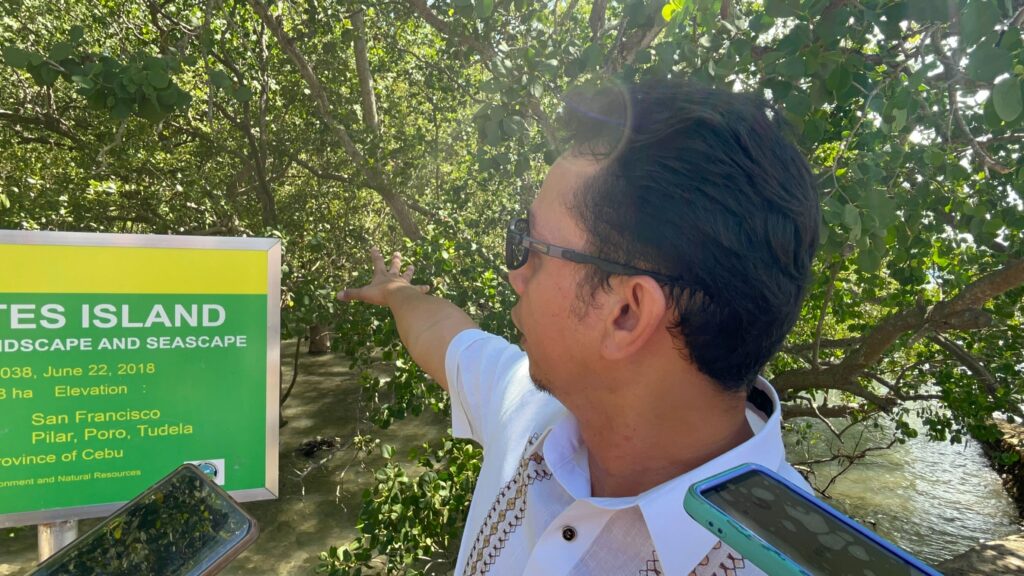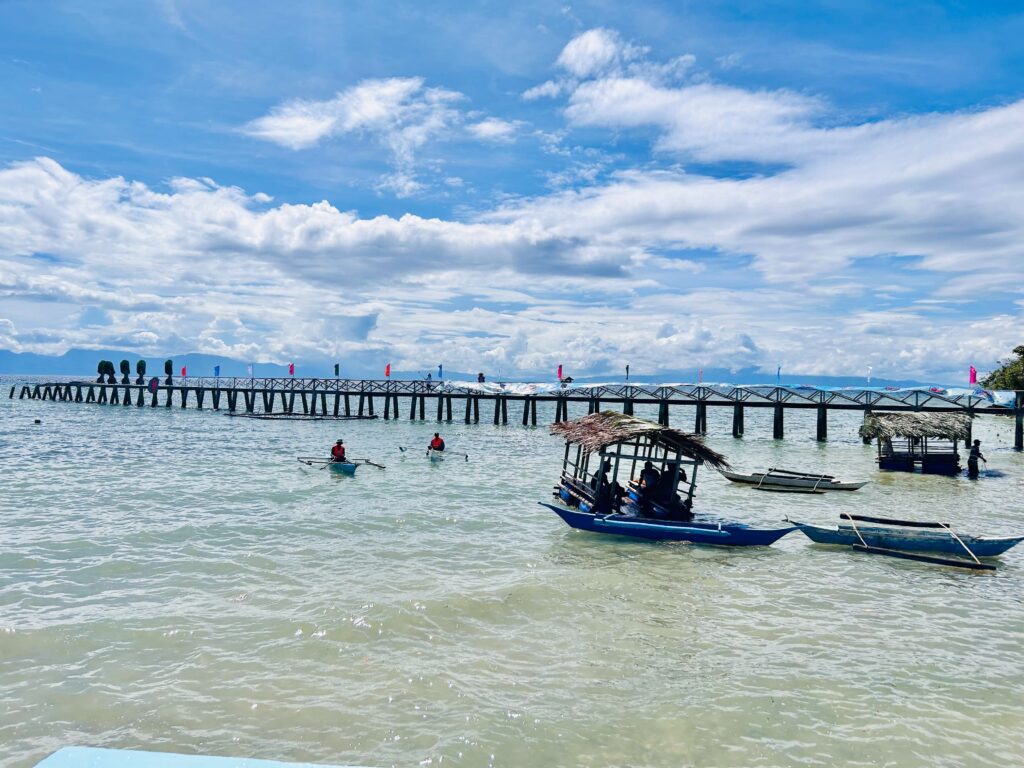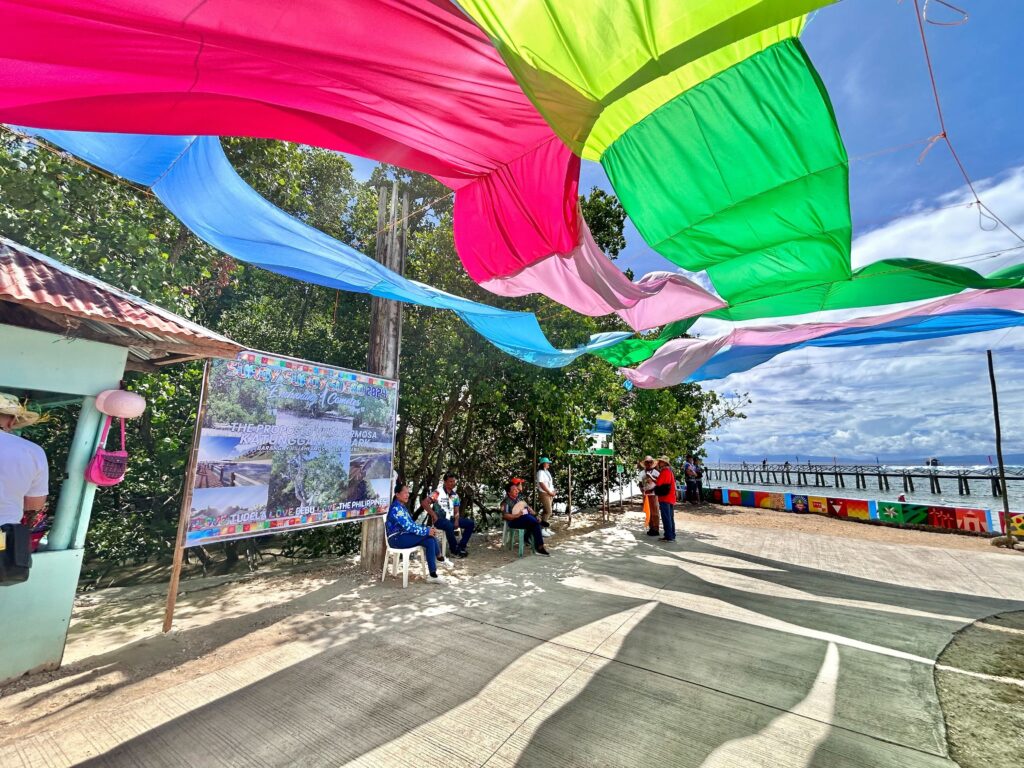Mangroves in Tudela brgy: Protecting those that give protection

The katunggan in Barangay Villahermosa in Tudela, Camotes. CDN Digital photo | Christian Dave Cuizon
CEBU CITY, Philippines — They say that humans are the cause of environmental destruction, hence, they are also the key individuals responsible for finding the solution.
In the northeastern part of Cebu, a group of islands called ‘Camotes’ is rich in biodiversity and is a paradise to many aquatic resources.
The town of Tudela, one of the four municipalities in Camotes, has the Villahermosa Marine Sanctuary, which is nestled in Barangay Villahermosa.
It is considered a protected landscape and seascape of Camotes by the virtue of Republic Act 11038 or the Expanded National Integrated Protected Areas System Act of 2018.
Giant clams, which are considered the largest clams in the world that can grow up to 4 feet can be found in this marine sanctuary.
But just within this marine sanctuary, a vital ecosystem can also be found—the mangroves or what are locally known as “katunggan.”
READ MORE:
‘Save Poro’s trees’: Parish church widens calls vs tree-cutting
Poro parish church urges gov’t: Don’t chop down our trees
Cebu lost 10,000 hectares of tree cover in the past 20 years
Benefits of mangroves
George Emperial III, a councilor in Villahermosa, said that the mangrove trees served as their town’s “protection” or “barrier” from typhoons and strong winds and waves.
“It has been protecting Barangay Villahermosa and other neighboring barangays. I think for the longest time, 60 or 40 years,” Emperial said.
Emperial, who heads the Toursim committee in their barangay, said that most of the mangrove trees in that area were “natural grown” but some of them were “man-planted.”
“Every year, we spend to plant additional mangrove trees kay di man malikayan ma damage, ang uban mangamatay tungod sa old age or wala na kaayo sila’y nutrients, so we need to freshen up the supply para naa gihapon ang protected layer sa amoa,” Emperial said.
(Every year, we spend to plant additional mangrove trees because damage cannot be avoided, the others died because of old age or they don’t have enough nutrients, so we need to freshen up the supply so that our protected layer will still remain.)
According to an article written by Adam Moolna, a teaching fellow in Environment and Sustainability in Keele University, mangroves are a unique and vital ecosystem found in the intertidal zones of tropical and subtropical coastlines around the world.
READ MORE:
Intense heat takes toll on young native trees in Pangasinan
Majority of Filipinos noticed climate change impacts in 2023, survey shows
Fighting climate change
Moreover, mangroves are also crucial in fighting climate change.
Daniel Alongi said in in his journal, ‘Carbon Cycling and Storage in Mangrove Forests’ that although mangroves occupy only 0.5 percent of the global coastal area, they still contributed 10 to 15 percent to coastal sediment carbon storage and export 10 to 11 percent of the particulate terrestrial carbon to the ocean.
“Their disproportionate contribution to carbon sequestration is now perceived as a means for conservation and restoration and a way to help ameliorate greenhouse gas emissions,” read a portion of his abstract.

George Emperial III, barangay councilor. CDN Digital photo | Niña Mae Oliverio
Emperial said the one benefit they also considered of their mangroves were their capacity to act as carbon filter.
“Mas kusog pa siya mosuyop or moabsorb og carbon dioxide kaysa sa atong mga local forest,” he said.
(They can quickly absorb carbon dioxide unlike other local forests.)
Furthermore, the Villahermosa councilor said that mangroves could also desalinate the salt water. “That means less and salinity sa tubig (in the water),” Emperial said.
This information can also be affirmed in ‘How Mangroves Desalinate Seawater’ written by P.F. Scholander.
According to the Rainforest Trust, 50 percent of the world’s biodiversity is found in rainforests and it is also among the most biologically diverse ecosystems on Earth.
However, between 35-50 percent of the world’s mangrove forests were lost between 1980 and 2000 which are the of some factors such as the conversion to aquaculture/agriculture, coastal development and climate-related sea-level rise.
Proposed Katunggan Ecopark
Acknowledging the benefits of mangroves to the community as well as the threats it faced, Emperial is urging all other local government units to plant mangrove trees when they can.
“We would like to encourage everyone, especially those who are living in coastal areas to protect your mangrove forest or plant mangrove trees. It’s for the benefit of the community and the nature and preservation, and for your safety as well,” said Emperial.

The Villahermosa Marine Sanctuary. CDN Digital photo | Niña Mae Oliverio
To furher encourage people and tourists who will be visiting their locality, Barangay Villahermosa is planning to convert the vicinity as an “ecopark” to be called as the “Katunggan Ecopark.”
Their proposal is still in progress with the LGU’s tourism office.
“We are making the structural foundation of having to declare Barangay Villahermosa Marine Sanctuary to be an ecopark. We really need to be legal and precise on our plans so that in the future, we can give way to other development,” he said.
Emperial is hoping that their proposal will be realised two to three years from now.
Should the proposed ecopark be implemented, they would be installing a “path” or a walkway in the middle of the mangroves so that the people could explore the beauty within.
Emperial said that they would also impose more precautionary measures to avoid accidents, and add more boats to those who would want to try and experience boating.
Moreover, they are also still looking for a budget to realize their proposal.

The proposed Katunggan Ecopark, taken last May 12. CDN Digital photo | Niña Mae Oliverio
“Everything that we’re doing in Tudela had been discussed with our beloved Governor Gwen Garcia and she is in full support sa mga plano sa (on the plans of) LGU Tudela,” Emperial added.
Having an ecopark, the councilor said, that it could also promote economic progress in their town, especially when it would become a tourist attraction in the future.
That way, the more people visit their place, there will be more opportunities for the residents to generate income from their homegrown products, and start their business.
The mangrove forest in Barangay Villahermosa was among the stops of the Suroy Suroy Sugbo: Enchanting 1 Camotes Island, a two-day excursion from May 11 to 12, 2024.
Suroy Suroy Sugbo is the Provincial Government’s flagship tourism program that would showcase the culture and heritage of cities and municipalities in Cebu Province. ###
References:
Alongi, D. M. (2014). Carbon cycling and storage in mangrove forests. Annual Review of Marine Science, 6(1), 195–219. https://doi.org/10.1146/annurev-marine-010213-135020
Moolna, A. (n.d.). How mangroves protect people from increasingly frequent and powerful tropical storms. The Conversation. https://theconversation.com/how-mangroves-protect-people-from-increasingly-frequent-and-powerful-tropical-storms-118200
Rainforest Trust. (2021, November 1). Mangroves – Rainforest Trust. https://www.rainforesttrust.org/our-impact/global-scope/mangroves/?utm_source=google-grant-uk&utm_medium=search&utm_campaign=our-impact-uk&utm_term=mangrove%20conservation&gad_source=1&gclid=Cj0KCQjw3ZayBhDRARIsAPWzx8ozDelebTx2CNAdbJZYOeAQmpK_nSeULaYgw2SzAB_ZwxgXtpEGh70aAuXnEALw_wcB
Scholander, P. F. (1968). How mangroves desalinate seawater. Physiologia Plantarum, 21(1), 251–261. https://doi.org/10.1111/j.1399-3054.1968.tb07248.x
Disclaimer: The comments uploaded on this site do not necessarily represent or reflect the views of management and owner of Cebudailynews. We reserve the right to exclude comments that we deem to be inconsistent with our editorial standards.

